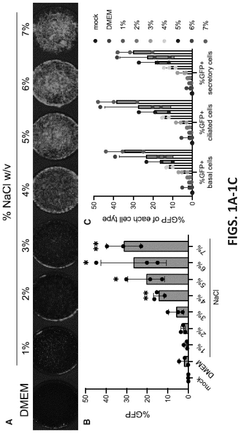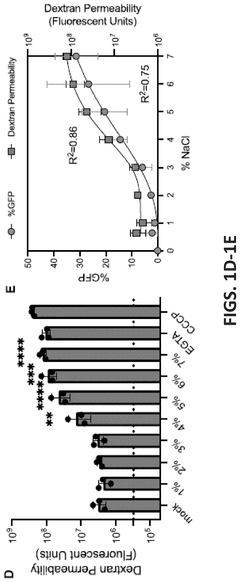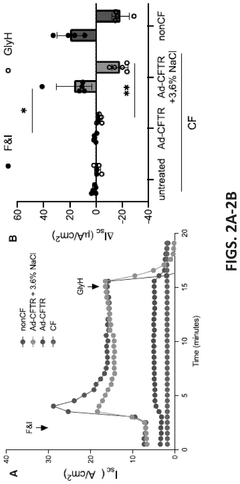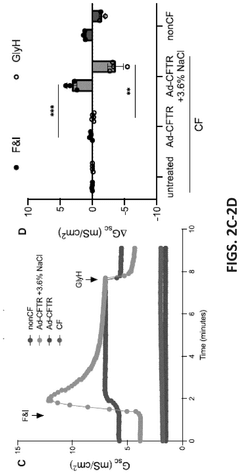How to Integrate Hypertonic Solutions in Livestock Care?
Hypertonic Solutions in Livestock: Background and Objectives
Hypertonic solutions have emerged as a promising avenue in livestock care, offering potential benefits in various aspects of animal health and productivity. The integration of these solutions into livestock management practices represents a significant shift in traditional approaches to animal husbandry. Historically, livestock care has primarily focused on nutrition, disease prevention, and environmental management. However, the introduction of hypertonic solutions marks a new era in addressing specific physiological challenges faced by animals in intensive farming systems.
The evolution of hypertonic solutions in livestock care can be traced back to advancements in veterinary medicine and animal physiology research. As our understanding of osmotic balance and fluid dynamics in animal bodies has improved, so too has the potential for targeted interventions using hypertonic solutions. These solutions, characterized by their higher solute concentration compared to bodily fluids, have shown promise in addressing issues such as dehydration, electrolyte imbalances, and certain metabolic disorders in livestock.
The primary objective of integrating hypertonic solutions into livestock care is to enhance animal welfare and optimize production efficiency. By manipulating the osmotic environment, these solutions aim to improve hydration status, support nutrient absorption, and potentially boost immune function in farm animals. This approach aligns with the growing emphasis on precision livestock farming, where tailored interventions are designed to meet the specific needs of individual animals or herds.
Current research and development efforts in this field are focused on several key areas. These include formulating species-specific hypertonic solutions, developing effective administration methods, and understanding the long-term impacts on animal health and productivity. Additionally, there is a growing interest in exploring how hypertonic solutions can be used in conjunction with other management practices to create comprehensive care protocols for different livestock species.
The integration of hypertonic solutions also presents an opportunity to address some of the pressing challenges in modern livestock farming. These include mitigating the effects of heat stress, improving recovery from transport-related dehydration, and potentially reducing the reliance on certain medications by supporting natural physiological processes. As the livestock industry continues to face pressures related to sustainability and animal welfare, innovative approaches like the use of hypertonic solutions offer promising avenues for improvement.
Market Analysis for Hypertonic Solutions in Animal Husbandry
The market for hypertonic solutions in animal husbandry has been experiencing significant growth in recent years, driven by the increasing demand for improved livestock health and productivity. The global market size for hypertonic solutions in animal care is projected to reach several billion dollars by 2025, with a compound annual growth rate exceeding 5% over the forecast period.
One of the primary factors fueling this market growth is the rising awareness among farmers and livestock managers about the benefits of hypertonic solutions in maintaining animal health and enhancing performance. These solutions are particularly effective in treating dehydration, electrolyte imbalances, and certain metabolic disorders in livestock, making them an essential component of modern animal care practices.
The market demand for hypertonic solutions is particularly strong in the dairy and beef cattle sectors, where maintaining optimal hydration and electrolyte balance is crucial for milk production and weight gain. Poultry and swine industries are also significant consumers of these products, especially in intensive farming systems where animals are more susceptible to stress and dehydration.
Geographically, North America and Europe currently dominate the market for hypertonic solutions in animal husbandry, owing to their advanced livestock management practices and higher adoption rates of innovative veterinary products. However, the Asia-Pacific region is expected to witness the fastest growth in the coming years, driven by the rapid modernization of the livestock industry in countries like China and India.
The market is characterized by a mix of large multinational pharmaceutical companies and specialized animal health product manufacturers. Key players are focusing on product innovation, such as developing ready-to-use formulations and improved delivery systems, to gain a competitive edge. There is also a growing trend towards the use of natural and organic ingredients in hypertonic solutions, catering to the increasing demand for chemical-free animal products.
Despite the positive outlook, the market faces challenges such as stringent regulatory requirements for veterinary products and the need for extensive education among small-scale farmers about the benefits of hypertonic solutions. Additionally, the rising concern over antimicrobial resistance is prompting researchers to explore alternative formulations that can enhance the efficacy of hypertonic solutions without relying on antibiotics.
In conclusion, the market for hypertonic solutions in animal husbandry presents significant opportunities for growth and innovation. As the livestock industry continues to evolve towards more intensive and efficient production systems, the demand for advanced health management solutions, including hypertonic products, is expected to rise steadily in the foreseeable future.
Current Challenges in Livestock Hydration Management
Livestock hydration management faces several critical challenges in modern agricultural practices. One of the primary issues is the difficulty in maintaining optimal hydration levels across diverse environmental conditions. Extreme weather events, such as heatwaves and droughts, can rapidly deplete water resources and increase the risk of dehydration in livestock. This variability in climate patterns necessitates adaptive hydration strategies that can respond quickly to changing conditions.
Another significant challenge is the inefficiency of traditional watering systems. Many farms still rely on outdated infrastructure that leads to water wastage through leaks, evaporation, and spillage. This not only increases operational costs but also puts unnecessary strain on limited water resources, particularly in arid regions. The lack of precision in water delivery often results in some animals receiving inadequate hydration while others overconsume.
The monitoring of individual animal hydration status presents a formidable challenge, especially in large herds. Current methods often rely on visual observation or sporadic sampling, which may not accurately reflect the real-time hydration needs of each animal. This imprecision can lead to delayed interventions and suboptimal animal health outcomes.
Water quality management is another critical concern in livestock hydration. Contaminated water sources can introduce pathogens and toxins into the herd, leading to disease outbreaks and reduced productivity. Ensuring consistent water quality across all watering points requires sophisticated filtration and treatment systems, which can be costly and complex to maintain.
The integration of technology in hydration management, while promising, brings its own set of challenges. Smart watering systems and IoT-enabled monitoring devices offer potential solutions but face hurdles in implementation. These include high initial costs, the need for technical expertise, and the challenge of ensuring reliable connectivity in rural agricultural settings.
Balancing hydration needs with other nutritional requirements adds another layer of complexity. Electrolyte imbalances and mineral deficiencies can affect water intake and retention, necessitating a holistic approach to animal nutrition and hydration management. This requires a deep understanding of the interplay between feed composition, water quality, and physiological needs of different livestock species and breeds.
Lastly, the regulatory landscape surrounding water use in agriculture is becoming increasingly stringent. Farms must navigate complex water rights issues and comply with environmental regulations while still meeting the hydration needs of their livestock. This regulatory pressure adds administrative and financial burdens to hydration management practices.
Existing Hypertonic Solution Applications in Animal Care
01 Medical applications of hypertonic solutions
Hypertonic solutions are used in various medical applications, including wound healing, reducing edema, and treating certain medical conditions. These solutions have a higher solute concentration than body fluids, which can help draw excess fluid from tissues and promote healing.- Medical applications of hypertonic solutions: Hypertonic solutions are used in various medical applications, including treatment of edema, intracranial pressure reduction, and as a component in wound healing therapies. These solutions can help draw excess fluid from tissues and promote osmotic balance in the body.
- Formulation of hypertonic solutions for specific treatments: Hypertonic solutions are formulated with specific concentrations and compositions for targeted treatments. These may include saline solutions, sugar-based solutions, or combinations of electrolytes designed to address particular medical conditions or physiological imbalances.
- Use of hypertonic solutions in cell culture and preservation: Hypertonic solutions play a crucial role in cell culture techniques and preservation of biological samples. They are used to maintain osmotic balance, control cell volume, and protect cells during cryopreservation processes.
- Hypertonic solutions in ophthalmic applications: Specialized hypertonic solutions are developed for ophthalmic use, including eye drops for treating dry eye syndrome and other ocular conditions. These solutions help maintain proper osmolarity of the tear film and reduce corneal edema.
- Industrial and agricultural applications of hypertonic solutions: Hypertonic solutions find applications in industrial processes and agriculture. They are used in water treatment, soil management, and as components in certain manufacturing processes where osmotic effects are beneficial.
02 Formulation of hypertonic solutions
The formulation of hypertonic solutions involves careful selection of solutes and their concentrations to achieve desired osmotic effects. Common ingredients may include salts, sugars, or other osmotically active compounds. The specific composition is tailored to the intended application and desired physiological effects.Expand Specific Solutions03 Use in cell culture and preservation
Hypertonic solutions play a crucial role in cell culture techniques and preservation of biological materials. They can be used to control cell volume, induce plasmolysis, or protect cells during cryopreservation processes. The osmotic effects of these solutions help maintain cell viability under various conditions.Expand Specific Solutions04 Applications in food and beverage industry
Hypertonic solutions are utilized in the food and beverage industry for various purposes, such as food preservation, flavor enhancement, and texture modification. The high solute concentration can help inhibit microbial growth and extend shelf life of certain products.Expand Specific Solutions05 Environmental and industrial uses
Hypertonic solutions find applications in environmental remediation and industrial processes. They can be used for soil treatment, wastewater management, or as part of separation and purification techniques in various industries. The osmotic properties of these solutions are exploited for specific technical purposes.Expand Specific Solutions
Key Players in Livestock Health Solutions Industry
The integration of hypertonic solutions in livestock care is an emerging field in the agricultural industry, currently in its growth phase. The market size is expanding as more farmers recognize the potential benefits of these solutions for animal health and productivity. Technologically, the field is advancing rapidly, with varying levels of maturity among key players. Companies like Cargill, Inc. and DSM IP Assets BV are leading in research and development, while academic institutions such as the University of Liege and China Agricultural University contribute significant scientific advancements. Pharmaceutical companies like Pfizer Inc. and Elanco US, Inc. are also entering this space, indicating a growing interest in commercializing hypertonic solutions for livestock care. The competitive landscape is diverse, with a mix of established agricultural firms, pharmaceutical companies, and innovative startups vying for market share.
Ceva Santé Animale SA
Cargill, Inc.
Innovative Approaches to Hypertonic Solution Delivery
- The use of a hypertonic solution, specifically a hypertonic salt solution with a salt concentration ranging from about 1% to 8%, is introduced to enhance the delivery of gene therapy vectors by contacting cells with it before, after, or simultaneously with the vectors, thereby improving gene transfer efficiency.
- A medicinal composition comprising hypertonic sodium chloride, a vasodilator, and a phosphate source, which reduces hemoglobin's intrinsic affinity for oxygen, increases oxygen transport, and enhances tissue oxygen extraction capacity, while maintaining acidosis to improve oxygen delivery to tissues.
Regulatory Framework for Animal Health Products
The regulatory framework for animal health products plays a crucial role in the integration of hypertonic solutions in livestock care. These regulations ensure the safety, efficacy, and quality of products used in animal husbandry, including hypertonic solutions. In the United States, the Food and Drug Administration (FDA) is the primary regulatory body overseeing animal health products, working in conjunction with the United States Department of Agriculture (USDA) for certain aspects of livestock care.
The FDA's Center for Veterinary Medicine (CVM) is responsible for the approval and regulation of animal drugs, including hypertonic solutions used in livestock. The approval process involves rigorous testing and evaluation to demonstrate the product's safety and effectiveness. Manufacturers must submit a New Animal Drug Application (NADA) or an Abbreviated New Animal Drug Application (ANADA) for generic products, providing comprehensive data on the product's composition, manufacturing process, and clinical trials.
In the European Union, the European Medicines Agency (EMA) oversees the regulation of veterinary medicinal products, including those used in livestock care. The EMA's Committee for Medicinal Products for Veterinary Use (CVMP) evaluates applications for marketing authorization and provides scientific opinions on the safety and efficacy of these products.
Regulatory bodies also establish guidelines for the proper use of hypertonic solutions in livestock, including dosage, administration methods, and withdrawal periods. These guidelines are essential to prevent residues in animal products intended for human consumption and to minimize the risk of antimicrobial resistance development.
Good Manufacturing Practices (GMP) are another critical aspect of the regulatory framework. Manufacturers of hypertonic solutions for livestock must adhere to GMP standards to ensure consistent product quality and safety. Regular inspections by regulatory authorities help maintain compliance with these standards.
Labeling requirements for animal health products, including hypertonic solutions, are strictly regulated. Labels must provide clear instructions for use, potential side effects, and any restrictions or precautions. This information is crucial for veterinarians and livestock producers to make informed decisions about product use.
The regulatory framework also addresses environmental concerns associated with the use of animal health products. Manufacturers may be required to conduct environmental impact assessments to evaluate potential risks to ecosystems and non-target species.
As the field of livestock care evolves, regulatory bodies continually update their guidelines and requirements to address new technologies and emerging concerns. This dynamic regulatory environment ensures that the integration of hypertonic solutions in livestock care remains safe, effective, and sustainable.
Environmental Impact of Hypertonic Solutions in Farming
The integration of hypertonic solutions in livestock care has significant environmental implications that warrant careful consideration. These solutions, while beneficial for animal health and productivity, can impact the surrounding ecosystem in various ways. One primary concern is the potential for increased salt concentrations in soil and water systems. When hypertonic solutions are administered to livestock, excess salts may be excreted through urine and feces, leading to accumulation in the immediate environment. This can alter soil chemistry, affecting plant growth and microbial communities essential for maintaining soil health.
Furthermore, the runoff from farms using hypertonic solutions may contribute to the salinization of nearby water bodies. Elevated salt levels in freshwater ecosystems can disrupt aquatic life, altering the balance of flora and fauna and potentially impacting biodiversity. This is particularly concerning in areas already facing water scarcity or quality issues, as it may exacerbate existing environmental stresses.
The production and disposal of hypertonic solutions also raise environmental concerns. Manufacturing processes may involve energy-intensive operations and the use of chemicals that could contribute to greenhouse gas emissions and pollution if not properly managed. Additionally, the packaging and transportation of these solutions add to the carbon footprint of livestock operations, highlighting the need for sustainable practices throughout the supply chain.
However, it is important to note that the environmental impact of hypertonic solutions can be mitigated through responsible management practices. Precision application techniques can minimize excess use, reducing the amount of salts introduced into the environment. Implementing proper waste management systems, such as containment and treatment of runoff, can prevent the spread of salts to surrounding ecosystems. Moreover, exploring alternative formulations that maintain efficacy while reducing environmental persistence could lead to more sustainable solutions.
The use of hypertonic solutions in livestock care also intersects with broader agricultural sustainability goals. By improving animal health and productivity, these solutions may indirectly contribute to more efficient land use and reduced resource consumption per unit of output. This efficiency could potentially offset some of the environmental costs associated with their use, provided that proper environmental safeguards are in place.
In conclusion, while hypertonic solutions offer valuable benefits for livestock care, their environmental impact must be carefully managed. Balancing the needs of animal health with environmental stewardship requires ongoing research, innovation in product formulation, and the development of best practices for application and waste management. As the agricultural sector continues to evolve, integrating environmental considerations into livestock care strategies will be crucial for ensuring long-term sustainability.







